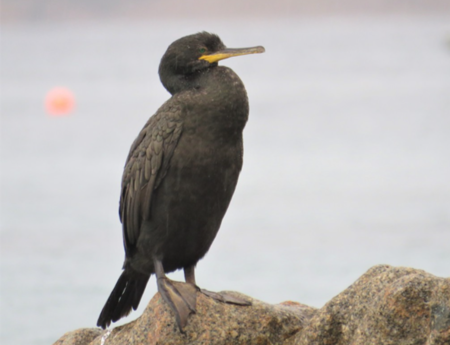Gulosus aristotelis desmarestii
Family: Phalacrocoracidae
Length: 65 – 80 cm
Wingspan: 90 – 105 cm
Weight: 1750 – 2250 g

Identification
Appearance: long neck, thin and hooked beak, relatively long tail. Juvenile: clear contrast between dark brown upper plumage and off-white lower plumage, pale-yellow feet. Adult: black plumage with bright green reflections, dark feet, emerald green eyes.
Distinguishing characteristics: smaller than Great cormorant, thinner bill and recurved crest in breeding season.
Flight: close to water with rapid wing beats; neck is usually fully extended.
Sound: rather silent away from colonies. In colony: clicking sounds; male makes series of grunts and clicks “ark-ik-ark-ik-ark-ik”.
Ecology and habitat
Nest: in the cliffs in natural crevices, rocky bits, on ledges or in the vegetation.
Diet: feeds mainly on fish near sandy and rocky sea beds.
Behaviour at sea: does not usually occur far from land, forage solitarily or in small groups, can socialize in large groups (up to few hundred individuals) and prey on schools of small pelagic fish.
* This map indicates coastal nesting sites in the Mediterranean and adjacent Seas.
Distribution and movement
Breeding: western Mediterranean: east coast of Spain, Balearic islands, Corsica, Sardinia, Tuscan archipelago, Lampedusa, Crete and the Ionian islands. Colonies in Albania, Bulgaria, Cyprus, Libya, Tunisia and Algeria. Wide breeding range along Turkish Black Sea coast.
Wintering: short-range migrant, dispersion from May-June to August, sometimes until October-November. Immature and non-nesting spend the summer away from the breeding sites. In the Adriatic Sea, Shags breeding in Croatia winters in the Gulf of Trieste.
Phenology: arrival to the colony: end of October. Laying: end of November-May, with a peak in January/February; three eggs (one to six). Incubation: 30 days. Fledging: end of February-end of June, eight weeks later.
Conservation
Global population estimate: 8,700 – 11,130 pairs; total non-breeding population: 30,000 individuals.
Threats: oil spills, bycatch in fishing gear, dinoflagellate blooms, prolonged adverse weather that impedes foraging.
Protection level: Barcelona Convention : Annex II; Bern Convention : Annex II; Birds Directive : Annex I; IUCN Red List: Least Concern.
Some key references
Bazin N & Imbert M (2012) Mediterranean Shag Phalacrocorax aristotelis desmarestii – Updated state of knowledge and conservation of the nesting populations of the Mediterranean Small Islands. Initiative PIM. 19p.
Koce U (2018) New marine IBAs for the Mediterranean Shag Phalacrocorax aristotelis desmarestii in Slovenia. Acrocephalus 39(178-179): 101-128.
Sponza S., Cosolo M., Kralj J. 2013. Migration patterns of the Mediterranean Shag Phalacrocorax aristotelis desmarestii (Aves: Pelecaniformes) within the northern Adriatic Sea. Italian Journal of Zoology 80(3): 380-391.
